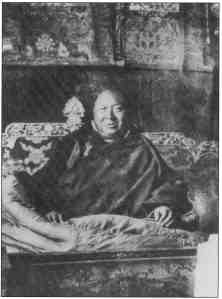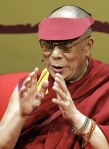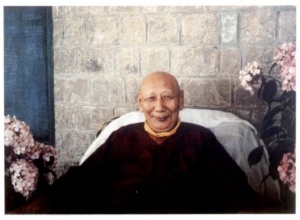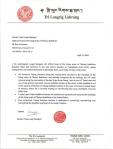Dorje Shugden practitioners have known for some time that Khensur Lungri Namgyal Rinpoche, the 101st holder of Je Tsongkhapa’s throne, or Ganden Tripa, is a practitioner of this protector.

101st Ganden Tripa Lungri Namgyal Rinpoche
It has been very interesting nonetheless, to watch what has happened as he has left office, his official seven year term completed. The Ganden Tripas have been the heads of the Gelugpa lineage since the time of Je Tsongkhapa. Perhaps it is interesting to note that the Ganden Tripa has traditionally been an elected position from within the monastery system of the Gelug tradition, but at some point since 1999, the Dalai Lama has inserted himself into the process, and the head of the Gelug tradition is now appointed by this political leader of Tibetans.
As Lungri Namgyal Rinpoche was nearing the end of his term in April of 2009, he did a remarkable thing. He wrote a letter.
Leaving no doubt as to his authority to do so,
I, the undersigned, Lungri Namgyel, the official head of the Gelug order of Tibetan Buddhism (Ganden Tripa) and successor to the said order’s founder, Je Tsongkhapa (1357-1419), whose headquarters are Ganden Monastery in Karnataka state, south India
the Ganden Tripa conferred upon Trijang Rinpoche and his Trijang Buddhist Institute, “the authority to represent and transmit the teachings of the Gelug order of Tibetan Buddhism in the United States.”
The previous Trijang Rinpoche, Trijang Dorjechang Losang Yeshe, was the greatest master of the previous century, and the Root Guru of the Dalai Lama. The current recognized reincarnation fo Trijang Rinpoche, recognized as such by the Dalai Lama, is a well known Dorje Shugden Practitoner like his predecessor, and his Trijang Buddhist Institute openly continues the practice in the United States.
For those who know little about this issue, it may not seem like much, but for anyone aware of the severe social and political penalties in Tibetan society for publicly going against the wishes of the Dalai Lama, it is a statement of tremendous import, not to mention courage. The fact that the Ganden Tripa waited until he was completing his career as a head of the tradition to make such a statement is also rather telling. It shows that while he held the office, it simply would have been too controversial. The Ganden Tri would likely have been removed from his office by the Government. That he had to wait until he was no longer subject to the Dalai Lama’s control to express his views, is indicative of the air of intimidation created by the Tibetan Government in Exile. For more detail on this topic, see Ganden Tripa Authorizes Trijang Buddhist Institute.
But it seems the story doesn’t end there. The latest news from South India is that the Ganden Trisur (the epithet Trisur refers to a retired Ganden Tripa such as Lungri Namgyal Rinpoche) has officially left Ganden Shartse, a monastery under the control of the Tibetan Government in Exile, for Shar Ganden Monastery. Shar Ganden is a new monastery that has recently been formed by those monks and lamas that have been expelled or otherwise made unwelcome at Ganden Shartse. It proudly and openly upholds the tradition of practicing Dorje Shugden as a wisdom protector of Manjushri Je Tsongkhapa’s teachings.

Shar Ganden Monastery, South India
Thousands of practitioners have left the traditional monasteries where they are subjected to bans, harassment and repression by the government and its enforcers, to join monasteries like Shar Ganden and Serpom Norling, a monastery formed from the practitioners previously associated with the Pomra Khangtsen of Sera monastery. These new monasteries are increasingly seen as the actual repositories of the Ganden tradition, free from Government interference, and many high lamas and tulkus have left the Government’s monasteries to join them.
Now, in a shocking move, the most recent head of the Ganden tradition along with his Labrang, or office, has joined them. The Ganden Trisur’s personal assistant related that, in the words of one member of the Dorje Shugden Forum,
HH Trisur Rinpoche had to wait this long until the term of office as Gaden Tripa completed to MAKE THIS MOVE BECAUSE IF HE HAD MADE THIS MOVE EARLIER, THE DALAI LAMA WOULD HAVE REMOVED HIM FROM OFFICE. And that would not be good for the Gelug on the whole. NOW THAT HE HAS FINISHED HIS TERM, HE CAN DO WHAT HE LIKES. NO ONE CAN TOUCH HIM, DISTURB HIM OR DISGRACE HIS POSITION. INCREDIBLE PLANNING. THIS WAS RELAYED BY HIS PERSONAL ASSISTANT!
It seems that the current Trijang Rinpoche and his entire office have also joined Shar Ganden Monastery.
Above all, it is sadly ironic that great Gelug Lamas like the Ganden Tripa and Trijang Rinpoche, whose previous incarnations include several Ganden Tripas, have had to leave Ganden Monastery in order to uphold Je Tsongkhapa’s lineage when Je Tsongkhapa established Ganden Monastery for precisely this purpose.
Has it ever been more clear that religion and politics should not be mixed? The brilliant founding fathers of the United States gave this gift to the people of this country, and this policy is also enshrined in the guiding documents of many of the most influential and prosperous western democracies. May the Tibetan people too gain the privilege of engaging in their spiritual practices without the ominous shadow of government control obscuring the light of religious freedom.










